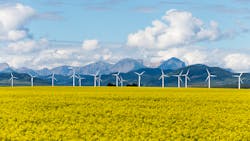Canada Launches Consultations on a Clean Electricity Standard
Canada's Minister of Environment and Climate Change, the Honourable Steven Guilbeault, this week launched consultations to develop Canada’s Clean Electricity Standard (CES) and drive progress toward a net-zero electricity grid by 2035. Work on clean electricity will also be key to reaching Canada’s ambitious emissions reduction target of 40 to 45% below 2005 levels by 2030 and net-zero emissions by 2050, according to a release from the government of Canada.
Canada already has 82% of electricity coming from non-emitting sources. New developments include Canada’s largest solar farm in Alberta’s Vulcan County as well as one of the world’s largest battery-storage energy projects in Haldimand County, Ontario, and the construction of Canada’s largest biofuel plant in Regina, Saskatchewan.
At home, moving to a net-zero grid by 2035 will create significant economic opportunities and jobs for communities across the country. Globally, it will allow Canada to continue leading in a highly competitive field. Similar to other important regulatory initiatives, a Clean Electricity Standard will send clear market signals to encourage investment in the clean technologies needed to move Canada’s electricity sector forward to a sustainable future. The Government of Canada stands ready to invest when and where possible to support our partners in this transition.
The development of a Clean Electricity Standard "must be a collaborative process between the federal government, provinces, territories, Indigenous groups, utilities, industry, and interested Canadians," the government's release said. This inclusive approach supports the competitiveness of the economy by providing a clear basis for provinces and territories to plan and operate their grids, while continuing to deliver reliable electricity to Canadians and keeping costs for households and businesses affordable.
Those interested are invited to submit comments on the Clean Electricity Standard discussion paper by April 15, 2022.
Quick facts
-
The introduction of a Clean Electricity Standard strengthens the Government of Canada’s commitment to achieving mandatory regulated sales targets of 100% of all new light-duty vehicle sold must be zero-emission vehicles by 2035, and 2040 for all medium- and heavy-duty vehicles, where feasible.
-
Energy-efficiency programs from the government of Canada are helping Canadians save money on their electricity bills. This includes the Canada Greener Homes Grant and the Low Carbon Economy Fund, and complementary programs from the provinces and territories.
-
In December 2020, the federal government announced new measures to support the electricity sector as part of the $15 billion in investments included in Canada’s strengthened climate plan, A Healthy Environment and a Healthy Economy. Measures specific to the electricity sector are outlined in the Clean Electricity Standard backgrounder.
-
On Feb. 14, 2022, the government of Canada announced the Future Electricity Fund as part of the Output-Based Pricing System (OBPS), which will reinvest $79.5 million to support clean electricity projects at electricity-generating facilities covered by the OBPS in Manitoba, Saskatchewan, Ontario, and New Brunswick.
-
To achieve net-zero emissions by 2050, Canada’s economy will need to be powered by both clean electricity and low-carbon fuels, such as hydrogen, advanced biofuels, liquid synthetic fuels, and renewable natural gas.
-
Current federal climate policies for the electricity sector include the phase-out of unabated coal by 2030, natural gas electricity emission standards, and carbon pollution pricing.
